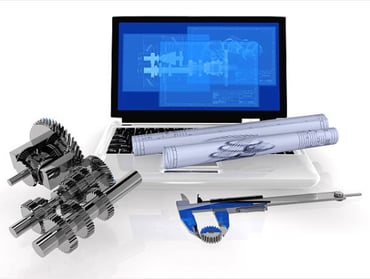Whether it’s a compressor, turbine, or an entire rocket turbopump design project we are tackling at Concepts NREC, we typically divide the design project into three phases: (1) scoping or feasibility study, (2) preliminary design, and (3) detailed design. Each of these phases has a specific purpose, although where one phase ends and the next phase begins can vary from project to project. The purpose and need for a scoping study was described in my blog posted last month, Why are Scoping Studies Necessary for Your Turbomachinery Project? In this blog I will describe the difference between preliminary design and detailed design.
Let’s start with summarizing what is accomplished during a scoping study phase. In this phase, initial calculations are performed to ‘size’ the piece of turbomachinery to meet what are often preliminary design specifications. This sizing includes determining the type and configuration of the turbomachinery (axial or radial, single stage or multistage), as well as operating characteristics (optimal rotational speed, performance maps). For a more complete scoping study, a preliminary 2D layout is created that reflects mechanical aspects of the design (bearing type and placement, seal type, housing layout, etc.). Often several configurations will be considered, and the best configuration with respect to the parameters most important to the client (performance, simplicity, design cost, manufacturing cost, etc.) will be selected for further design effort.
With these initial calculations complete, the next level of design work can begin, but only after one other item is available: a complete design specification. If a design specification was not completed as part of the scoping study, the specification must be completed before further design work can begin. The client can complete the design spec themselves, or we can help the client ‘fill in the blanks’ and define a complete spec. More times than we would like to admit we have started a design and realized that the design intent was in some way not fully defined or not fully understood by either us or our client, hence we are very particular about having a complete design spec in place. More detailed design specs are needed for a preliminary/detailed design than for a scoping study. For example, often in a scoping study only a single design point is considered. If there are multiple off-design points that are important to the client, these off-design points should be considered during the scoping study, or at least fully identified in a design spec so they can be addressed during preliminary/detailed design. Often in scoping studies the focus is on aerodynamic performance to see if a cycle condition can be met, an outcome which might determine if a project is viable. But in preliminary/detail design, mechanical design often dominates the effort and all specifications related to mechanical design must be in place, including items like life requirements (number of cycles, number of operating hours), environmental considerations (this unit must run in -30F to +120F ambient conditions), manufacturing limitations (we don’t want to pay for expensive/exotic materials), and interface requirements (how will the unit be mounted? what types of fittings are needed for instrumentation leads? etc.). Indeed, an entire blog could be written just on how important it is to have a full design specification in place before preliminary/detailed design begins.
After the scoping study is complete and a good design spec is in place, further design work can begin. This design work is typically divided into at least two phases, preliminary design and detailed design. with each of these phases having a different purpose as follows.

Preliminary Design
In the preliminary design phase, more detailed engineering design/analysis calculations are performed on at least the major elements of the component. The major elements include the aerodynamic flowpath (inlets, impellers, diffusers, exit elements), the rotating group (shafting, bearings, seals), and the static housings (including the bearing housing). A first pass analysis is typically done in each technical area in order to further develop the design. In addition, relative to a scoping study, in a preliminary design the next level of sub-component detail is examined. This next level can include looking at parameters such as seal leakage, axial and radial thrust (and thrust control if thrust exceeds bearing capacity), mechanical containment, impeller/rotor attachment, etc.
One of the hallmarks of the preliminary design phase is the execution of trade studies. Typically in turbomachinery design there are options on how you can approach a design or analysis, and a trade study is often used to determine the best path forward. A trade study could involve selecting the best rotational speed to optimize the overall performance of a turbopump, where the optimal speed for the pump and for the turbine are different. Or a compressor might operate over a range of conditions (high flow/high pressure ratio, low flow/high pressure ratio, low flow/low pressure ratio), and the best ‘design point’ is not really at any of these three conditions (https://www.conceptsnrec.com/blog/there-is-no-such-thing-as-a-design-point), and a trade study or optimization might have to be done to select the best design point. Trade studies are often done for mechanical components, perhaps evaluating several different bearing types to select the most suitable bearing given rotordynamic, life, and cost requirements. Trade studies and trade tables are common in the preliminary design phase as the design is refined from a concept to more of an optimized configuration. For these trade studies our clients often identify the drivers and priorities for their project, including factors such as aerodynamic performance, operating life, size/weight, manufacturing cost, development time/cost, etc., so we know how to weight the trade studies.
How do you know when a preliminary design is complete? At the end of preliminary design, it is typical that a layout has been solidified, subcomponents have been down-selected (bearings, seals, etc.), a first pass analysis of at least all critical components has been completed, and a refined performance estimate has been generated. Note that the design is not final and not all needed analyses have been completed, but enough work has been done to verify the design is viable and is still capability of meeting the design specification. Another important outcome from preliminary design is the identification of risk areas that must be further addressed in detailed design, typically by refined and more involved analysis. To be honest it can be somewhat gray when a preliminary design is complete and the detailed design can start – usually we work out this split with our clients during the proposal/planning phase of a project. One last critical element of the preliminary design phase is a complete design review, always internally, and often externally with our client if they chose to be involved at this level to fully review the work done to date and to agree to proceed with detailed design.
Detailed Design
In the detail design phase, analyses are taken to the next level, either refined to be more accurate, or extended to additional operating conditions. There is a saying that goes ‘the devil is in the details’, sometimes attributed to the German philosopher Nietzsche. While Nietzsche might have intended a more philosophic meaning, we can certainly apply this saying to the design phase of turbomachinery. There are typically a lot of details in detailed design that need to be analyzed, refined, and completed correctly for the turbomachinery component to fully vetted and optimized. Even when an analysis is refined and run with perhaps a higher density mesh or more refined boundary conditions, the analysis is still often not done, and must be re-run at other operating conditions or other ambient conditions. The detailed design phase is where all this refinement happens, and this phase of the project can be the most cost and schedule intensive phase.
At Concepts NREC, we usually include the creation of CAD models and manufacturing drawings in the detailed design phase. Sometimes the CAD work is broken out separately depending on the needs of our clients, but often CAD models are made anyway during the detailed design phase for either component analysis or to complete a layout/assembly, so it makes some sense to keep the detailing of the models for manufacturing and the creating of the associated manufacturing drawings in the detailed design phase. Indeed, tasks like tolerances stacks to set drawing/manufacturing tolerances are best done in conjunction with the analyses that give input to these stacks (such as calculation of hot-to-cold deflections). In many cases the end of the detailed design phase is indicated by completion of manufacturing drawings. Certainly, detailed design reviews must also be held to close out the design effort, but many consider best practice to have reviews before the manufacturing drawings are completed or even started, in order to catch any issues in time for a last round of design/analysis refinement.

Conclusion
The information presented here is just a brief overview of these two design phases; there is so much more to organizing and running a project. At Concepts NREC we follow many of the Project Management Institute (PMI) guidelines, and many of our staff are PMI trained. Topics such as risk management, concurrent engineering (including ordering long lead time parts before design is complete), and resource availability and loading should be all addressed in any project plan, no matter how you break up your design phases. In addition to applying PMI principles for project management, Concepts NREC is ISO9001 and AS9100 certified, and we follow procedures defined for these quality management systems in our project planning and execution.
If you would like to discuss how we would approach your turbomachinery design project, please contact us at info@conceptsnrec.com #turbomachinery #engineering #compressor #turbine #pump






